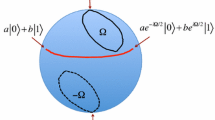Abstract
Digital computation—i.e., the coherent concatenation of logicalif/then statements—is generally mapped onto the temporal transformation of a physical state. In the alternative paradigm of steady, simultaneous quantum computation, logical concatenations are mapped onto the transformations of a quantum steady state into itself. Such transformations, separated from the time variable and thus freed from the one-way progression of time, can mapcircular logical concatenations. This gives rise to nondeterministic and nonrecursive computation. Toy model Hamiltonians of elementary (steady) computations are given to exemplify the applicability of the paradigm.
Similar content being viewed by others
References
Albert, D. Z. (1983).Physics Letters,98A, 249.
Baez, J. C. (1983).Transactions of the American Mathematical Society,208, 339.
Bennett, C. H. (1982).International Journal of Theoretical Physics,21, 905.
Birman, J. (1982).Braids, Links, and Mapping Class Group, Princeton University Press, Princeton, New Jersey.
Brasher, J. D., Hester, C. F., and Caulfield, H. J. (1991).International Journal of Theoretical Physics,30, 973.
Castagnoli, G. (1991).International Journal of Modern Physics B,5, 2253.
Castagnoli, G., and Vincenzi, A. (1991). Quantum simultaneous machines and computability, inProceedings of the 9th International Congress of Logic, Methodology and Philosophy of Science, Uppsala, Volume III, p. 13.
Castagoni, C., Rasetti, M., and Vincenzi, A. (1992).International Journal of Modern Physics C,3, 661.
Deutsch, D. (1985).Proceedings of the Royal Society of London A,400, 97.
Drin'feld, V. (1985).Mathematics Doklady,32, 254.
Falikov, L. M., and Kimball, J. C. (1969).Physical Review Letters,22, 997.
Feynman, R. P. (1986).Foundations of Physics,16, 507.
Fredkin, E., and Toffoli, T. (1982).International Journal of Theoretical Physics,21, 219.
Geroch, R., and Hartle, J. B. (1986).Foundations of Physics,16, 533.
Hubbard, J. (1963).Proceedings of the Royal Society of London A,276, 238.
Hubbard, J. (1964).Proceedings of the Royal Society of London A,277, 237.
Kreisel, G. (1974).Synthèse,29, 11.
Manin, Y. (1989).Communications in Mathematical Physics,123, 163.
Penrose, R. (1989).The Emperor's New Mind, Oxford University Press, Oxford.
Pour-El, M. B., and Richards, I. (1983).Advances in Mathematics,48, 44.
Woronowicz, S. (1987).Publications RIMS, Kyoto University,23, 117.
Author information
Authors and Affiliations
Rights and permissions
About this article
Cite this article
Castagnoli, G., Rasetti, M. The notions of symmetry and computational feedback in the paradigm of steady, simultaneous quantum computation. Int J Theor Phys 32, 2335–2347 (1993). https://doi.org/10.1007/BF00673003
Received:
Issue Date:
DOI: https://doi.org/10.1007/BF00673003




